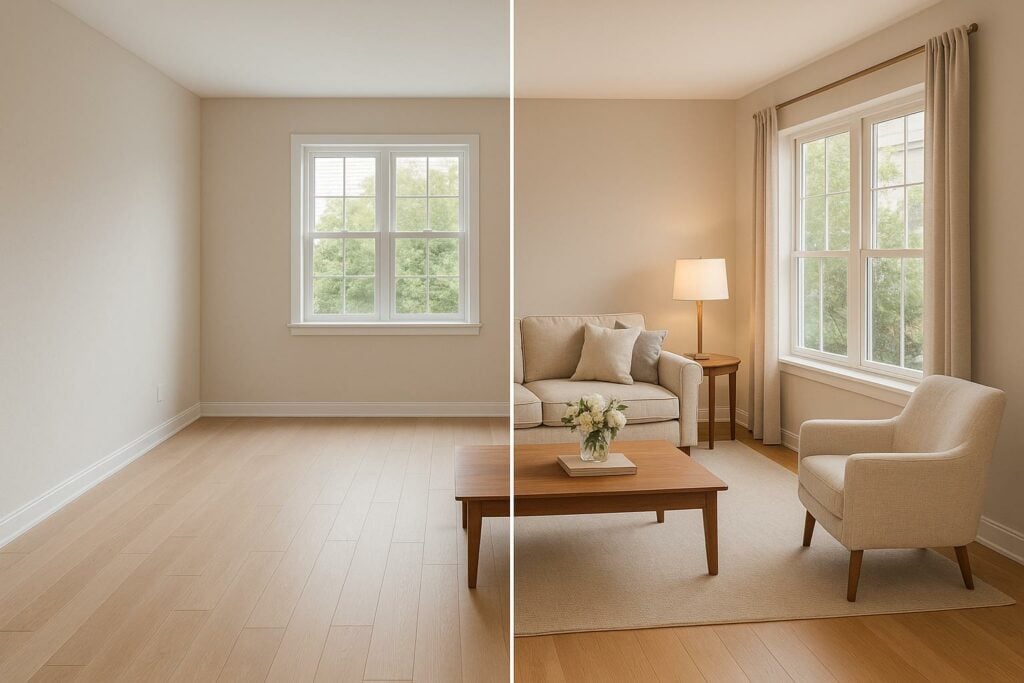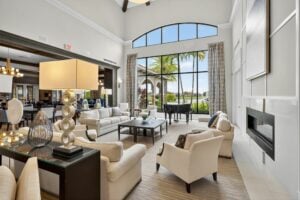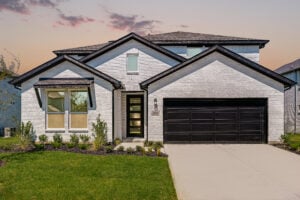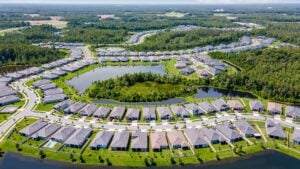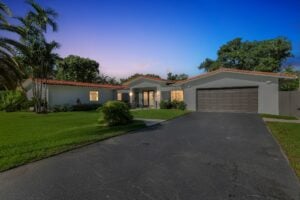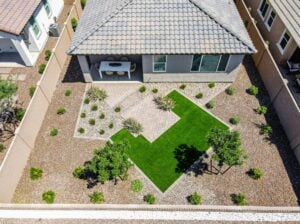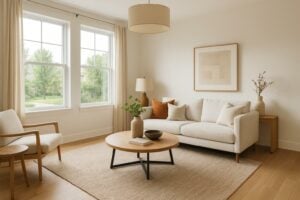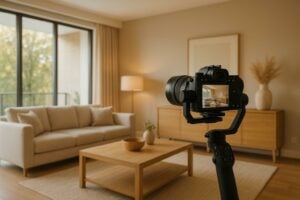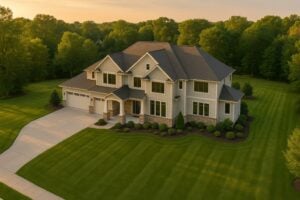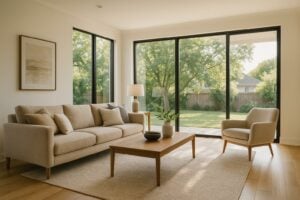Want to sell your home fast and for more money? The way it’s photographed – vacant or staged – makes all the difference.
- Vacant Homes: Highlight architectural details and space but can feel cold and impersonal. They sell for $11,306 less and stay on the market six extra days on average.
- Staged Homes: Create a warm, inviting atmosphere, helping buyers visualize living there. They sell 73% faster and for 5–10% more than non-staged homes.
Quick Comparison
| Factor | Vacant Homes | Staged Homes |
|---|---|---|
| Focus | Architectural details, space | Furniture arrangement, lifestyle |
| Emotional Impact | Neutral, requires imagination | Warm, inviting, easier connection |
| Cost | Lower (no staging costs) | Higher (staging expenses) |
| Market Performance | Sell slower, lower offers | Sell faster, higher offers |
Key Insight: Staged homes are more visually appealing and emotionally engaging for buyers, but vacant homes can work if they emphasize standout features or use virtual staging.
Want the best results? Tailor your photography to the property’s strengths and buyer expectations.
Vacant vs Furnished Home
Photographing Vacant Homes
Vacant homes provide a clean slate, showcasing architectural features without the distractions of furniture. However, this simplicity can sometimes feel a bit cold or impersonal.
Key Aspects of Vacant Home Photography
When photographing vacant homes, the focus is on three main elements: architectural details, natural light, and spatial flow. Without furniture drawing attention away, photographers can emphasize standout features like exposed beams, vaulted ceilings, custom staircases, or built-ins that define the home’s character. To make the most of natural light, open all curtains and blinds, and use wide-angle lenses to capture the scale and flow of each room.
Why Vacant Home Photography Works
Vacant homes put every architectural detail – like crown molding, hardwood floors, or intricate trims – front and center. There’s no clutter or decor to compete for attention. Another advantage? You can skip costly furniture rentals or elaborate staging setups, giving photographers the freedom to experiment with angles and perspectives. These open spaces also encourage potential buyers to imagine their own furniture and belongings in the space, helping them visualize how they’d make it their own.
Challenges to Consider
While vacant homes have their perks, they can also present obstacles. Without furniture, rooms might feel smaller or lack the warmth that helps buyers form an emotional connection to the property. One way to counter this is through HDR photography, which blends multiple exposures to create a more inviting and balanced look.
Virtual staging is another game-changer. Services like HomeJab’s virtual staging can transform empty rooms into fully furnished spaces for a fraction of the cost of traditional staging.
It’s also worth noting that empty spaces tend to highlight imperfections – scuffed floors, smudged walls, or dusty corners become more noticeable. A thorough cleaning and the inclusion of a detailed floor plan can help ensure the home presents its best face to potential buyers.
"Photography is a powerful tool for selling the dream of a vacant property." – WindowStill
The secret to successful vacant home photography lies in using the right techniques to turn empty rooms into inviting visual stories. Up next, we’ll explore staged home photography, where decor plays a key role in shaping a home’s appeal.
Photographing Staged Homes
Staged homes bring furniture and decor into the mix, creating a warm, inviting atmosphere that helps potential buyers imagine themselves living there. Unlike vacant homes, which rely on architectural details alone, staged spaces tell a story, making them more visually appealing and easier to photograph.
How Staging Works in Real Estate Photography
Staging is all about arranging furniture and accessories in a way that highlights the property’s best features and makes it shine on camera. It’s not just about filling a space – it’s about creating a mood and helping buyers connect emotionally with the home.
When preparing a staged home for photography, the focus is on a few key elements: maximizing natural light, arranging furniture to enhance the room’s flow, and keeping the decor neutral so buyers can picture their own belongings in the space. Photographers often open curtains or blinds to bring in as much natural light as possible and use additional lighting to ensure every corner is well-lit.
Attention to detail is critical. Surfaces are cleared of clutter, personal items are removed, and furniture is positioned to showcase the room’s layout and potential. As Dalton Carroll, a top-selling agent with Lionheart Real Estate Group, puts it:
"Listing photographs are the most important thing always because buyers these days get their first impression of your home online… Your listing photos need to set expectations for potential buyers and get them excited to see your house in person."
This meticulous approach ensures the home looks its best, helping to create photos that grab attention and drive interest.
Benefits of Staged Home Photography
Staging can make a real difference in how quickly and for how much a home sells. On average, vacant homes sell for $11,306 less and spend six extra days on the market compared to staged properties. Staged homes tend to stand out in online listings, drawing more eyes and generating more interest. In fact, 89% of homebuyers say photos are a critical part of their home search.
The numbers back it up: 20% of sellers’ agents report that staging increases offers by 1–5%, while 25% of buyers’ agents say staging impacts the offer price. Of those, 17% note an increase of 6–10%.
Staging also helps minimize imperfections. By focusing on a home’s strengths, neutral color schemes and professional styling can create a polished, magazine-like appearance that photographs beautifully.
Drawbacks of Staged Home Photography
Despite its advantages, staging isn’t without challenges. The biggest hurdle? Cost. Traditional staging often involves renting furniture, hiring professional stagers, and dedicating extra time to preparation, which can delay the listing process.
Overdoing it is another potential pitfall. Overly elaborate or personal decor can distract from the home’s natural charm. And as Karen Otto from Home Star Staging points out:
"A photographer is NOT a stager and should not be expected to act as one in the process of photographing the home. For agents who put a photographer in that position on site it is also very unprofessional in the eyes of a client."
Staged homes also require precise lighting and careful styling to avoid issues like harsh shadows or visual clutter. Even small details, such as wrinkled linens or overlooked messes, can be exaggerated in photos, making professional preparation a must.
For homes where physical staging isn’t feasible, virtual staging offers a budget-friendly alternative, with services like HomeJab charging $50 per photo.
The trick is finding the right balance – using staging to elevate the property’s appeal while ensuring the home itself remains the focal point.
sbb-itb-82c5f45
Photography Differences: Vacant vs. Staged Homes
When it comes to listing homes, the difference between photographing a vacant property and a staged one can be striking. Vacant homes focus on showcasing architectural details and structural elements, while staged homes aim to evoke a sense of comfort and style. Each approach triggers a distinct emotional response in potential buyers.
Vacant home photography often employs wide-angle shots to highlight space, natural light, and the unique textures and materials of the property. This method emphasizes the home’s structure and flow. On the other hand, staged home photography is all about creating a sense of functionality and warmth. Furniture placement is carefully designed to guide the viewer’s eye and showcase how the space can be lived in.
The emotional response these styles generate is a critical distinction. Vacant homes rely on the buyer’s imagination to envision the potential, which can sometimes make it harder to form an immediate connection. Staged homes, however, make that connection easier by offering a ready-made vision of what life in the home could look like. This is especially important since buyers spend about 60% of their time looking at listing photos. The table below highlights these key differences.
Comparison Table: Key Aspects
| Factor | Vacant Home Photography | Staged Home Photography |
|---|---|---|
| Visual Focus | Architectural details, space, and structure | Furniture arrangement and lifestyle demonstration |
| Emotional Impact | Can feel cold and impersonal | Creates a warm, inviting atmosphere |
| Buyer Connection | Requires imagination to envision potential | Easier emotional connection and visualization |
| Photography Style | Wide angles, emphasis on flow and light | Intimate spaces, guided eye movement |
| Preparation Time | Minimal setup required | Extensive staging and styling needed |
| Cost | Lower upfront investment | Higher due to staging expenses |
| Market Performance | May stay longer on the market | Sells 73% faster than non-staged homes |
| Sale Price Impact | Potential for lower offers | Can sell for 5-10% more |
When to Choose Each Approach
Deciding between these two styles depends on your budget, target market, and the property’s unique characteristics. On average, staged homes sell in 23 days, compared to 184 days for vacant properties.
Vacant home photography works best for properties with standout architectural features or modern designs that emphasize clean lines and natural light. It’s also a practical choice when staging costs are too high or the timeline is tight. Think of homes with dramatic windows, open floor plans, or unique structural elements that can shine on their own.
Staged home photography, on the other hand, is ideal for buyers who might struggle to imagine the potential of an empty space. This is especially effective for older homes, properties with unconventional layouts, or spaces that may feel smaller when empty. In fact, 83% of buyers’ agents say staging helps buyers visualize the property as their future home.
For sellers on a tight budget, virtual staging offers a cost-effective alternative. Services like HomeJab provide virtual staging for just $50 per photo, allowing you to add warmth and personality to vacant spaces without the expense of renting furniture or hiring professional stagers.
Ultimately, the choice comes down to aligning your photography strategy with the property’s strengths and the expectations of your target audience. For example, luxury buyers often expect staged homes, while investors may prefer to see the raw potential of a vacant property. Tailoring your approach to your local market and buyer preferences can make all the difference.
Impact on Real Estate Listings and Buyer Perception
The way you photograph a property can significantly influence how buyers perceive its value. In fact, 85% of homebuyers say photos are the most important factor when searching for homes online. This means that the visual appeal of your listing often determines whether a potential buyer decides to take the next step. Let’s break down how photography choices affect the performance of real estate listings.
Effect on Listing Performance
Using professional photography can dramatically improve how a listing performs. Properties with high-quality photos receive 118% more online views compared to those with lower-quality images. Beyond just views, professional photos help homes sell faster – 32% quicker, to be exact – and for 47% higher asking prices per square foot.
The difference becomes even more striking when comparing vacant homes to staged ones. Vacant properties sell for an average of $11,306 less and spend six extra days on the market compared to staged homes. These stats clearly show how photography and presentation directly influence buyer behavior and the overall marketability of a listing.
"When potential buyers view property listings, their emotional centers become highly active, particularly when engaging with images that help them visualize life in the home." – imgix
For sellers looking to maximize appeal without the expense of traditional staging – which can cost between $766 and $5,000 or more – virtual staging offers a budget-friendly alternative at just $50 per photo through services like HomeJab.
Buyer Preferences and Trends
The impact of great photography extends to buyer behavior. With nearly 90% of buyers starting their search online, your listing photos are often the first impression. The style of photography used can attract different types of buyers and shape their perception of the property.
Lauren Matthews, design director and co-founder of White Orchid Interiors, highlights the stark contrast in buyer responses to vacant versus staged homes:
"What happens when a home is vacant – it attracts low-ball offers from investors and people who think that the home is either distressed or that the sellers are desperate."
On the other hand, staged homes evoke a completely different reaction. Matthews explains that these properties draw higher-quality buyers who are emotionally invested and more likely to engage in bidding wars. Staged homes give buyers the impression of being move-in ready, often sparking thoughts like:
"Families feel like, ‘oh, I could move in tomorrow. You know, all I have to do is close and we’re ready to go.’"
Data from the National Association of Realtors (NAR) supports this trend. Eighty-three percent of buyers’ agents report that staging helps buyers visualize the property as their future home. Additionally, 29% of real estate agents say staging results in offers that are 1% to 10% higher in value.
Modern buyers also show a growing preference for homes that look "TV-ready", inspired by popular home design shows. This has made professional photography and staging even more essential in today’s market.
Virtual staging, in particular, is transforming property marketing. It offers an impressive return on investment (ROI) of 500% to 3,650%, compared to traditional staging’s ROI of 102% to 909%. Virtually staged properties also sell much faster – spending an average of just 24 days on the market, compared to 90 days for vacant homes.
Jessica Lautz, deputy chief economist and vice president of research at NAR, underscores the importance of proper presentation:
"The typical home seller resides in their home for 10 years before selling. During that time, homeowners might overlook certain aspects that could be less appealing to potential buyers. By staging a home, agents who are Realtors® strategically highlight the best features, ensuring sellers receive the most-competitive offers."
Conclusion
The decision to photograph vacant versus staged homes plays a key role in shaping buyer perceptions and the overall success of a property listing. Each method brings unique strengths to the table, making it essential to know when and how to use them effectively.
Key Takeaways
Vacant homes showcase architectural details and structural elements, highlighting open spaces and flow. This approach provides a blank slate for buyers to imagine their own design ideas, but it can feel impersonal, often appealing more to investors than families looking for a ready-to-move-in home.
Staged homes, on the other hand, tell a story. They highlight lifestyle possibilities and bring warmth and personality to a space, helping buyers see how the home could fit into their lives. As Lauren Matthews from White Orchid Interiors explains:
"Staged homes just show better – regardless of the market".
Photographing each type of property requires a distinct approach. For vacant homes, focus on architectural features and spatial flow, using a clean, minimalist style to emphasize the property’s potential. For staged homes, capture the inviting atmosphere created by furniture and decor, showcasing how each space functions and feels.
For properties that aren’t physically staged, virtual staging offers a practical alternative. It allows buyers to visualize a home’s potential without the costs of renting physical furniture, bridging the gap between empty and fully staged spaces .
The Value of Professional Real Estate Photography
Professional photography is a game-changer in real estate marketing. With 95% of buyers starting their search online, high-quality images aren’t just helpful – they’re essential. Great photos attract more views, generate interest, and ultimately drive sales.
HomeJab specializes in delivering top-tier photography services tailored to both vacant and staged homes. Their HDR photography packages, priced between $229 and $379, are designed to highlight the architectural beauty of vacant properties. For empty homes needing an extra touch, their virtual staging service transforms bare spaces into welcoming, furnished rooms, helping buyers picture their future home. Plus, with a 24-hour turnaround time, HomeJab ensures you can adapt your marketing strategy quickly and efficiently.
The goal of professional photography goes beyond merely documenting a property. It’s about creating images that inspire action. Whether you’re emphasizing the spacious potential of a vacant home or the lifestyle appeal of a staged one, professional photography turns listings into powerful tools that engage buyers and drive results.
FAQs
What are the cost and effectiveness differences between virtual staging and traditional staging?
Virtual staging is a much cheaper alternative, with prices typically falling between $15 and $100 per image, compared to traditional staging, which can range from $750 to $5,000 or more, depending on the size of the home and the furnishings used. This affordability makes it an appealing choice for sellers looking to save money.
And it’s not just about saving money – it works. For homes priced under $750,000, virtual staging can deliver an incredible return on investment (ROI) of up to 3,650%. Plus, staged homes, whether done virtually or through traditional methods, often sell faster and fetch higher prices. Many of these homes are off the market in 11 days or less. Virtual staging provides a budget-friendly way to present properties online without sacrificing results, making it a go-to option for sellers.
What are the best techniques for photographing vacant homes to make them more appealing?
To make vacant homes shine in photos, photographers can use a few smart techniques. Start with a wide-angle lens to capture the full layout of each room, giving the impression of more space and openness. Leverage natural light by opening curtains or blinds and snapping pictures during the golden hours – early morning or late afternoon – for a warm, cozy vibe.
Be mindful of angles that emphasize the room’s standout features, and ensure the area is spotless and free of clutter. If possible, add small staging elements like a vase or a piece of artwork to create a more inviting atmosphere. These simple steps can highlight a property’s potential and make it more appealing to potential buyers.
Why do buyers often prefer staged homes over vacant ones in online real estate listings?
Buyers are often drawn to staged homes because they make it easier to picture the space as a welcoming home. When rooms are thoughtfully furnished, it becomes clear how each area can be used, helping buyers imagine their own lives unfolding there. On the other hand, empty homes can feel uninviting or even sterile, making it harder for buyers to form an emotional connection.
Beyond aesthetics, staging can also lead to quicker sales and higher offers. A well-staged home creates an inviting, polished look that grabs attention and showcases the property’s potential. For sellers, this can mean a smoother process and a better return on investment.

